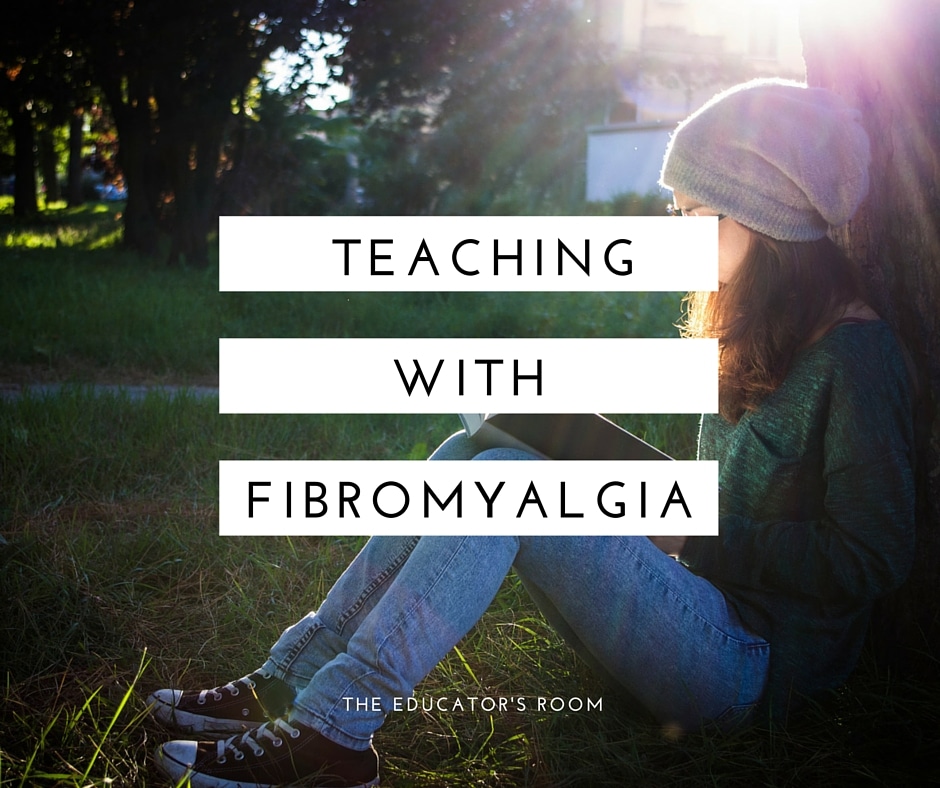The teaching profession, as all us teachers know, is exhausting most days. You do things like greet students happily, come up with engaging lessons, put students in collaborative groups, deal with sassy students without losing composure, prevent students from getting into fights, go to meetings that last an hour or more, handle student behaviors during lunch, teach differentiated lessons, and remain positive at all times. It’s hard to do these things all every day even without a disorder.
Sometimes I wake up exhausted and so sore that I feel as if I lifted a thousand weights the day before. The exhaustion alone makes it difficult to get out of bed, but the pain really makes it difficult to move. After hitting the snooze button three times, I get up and get myself and my kids ready to go. I do my best not to forget things as I walk hurriedly out of the door, having gotten ready far too quickly due to my lag time in getting up. During the day, I sometimes struggle to explain things to my students, and this embarrasses me because I know my content, but my memory gets the best of me and I lack the instant recall I used to possess before fibromyalgia came along and started messing with my body and my mind.
With the musculoskeletal pain, sleep problems, memory problems, and depression/anxiety due to fibromyalgia and it sometimes feels like an impossible task. If you’re teaching with this disorder and you feel like you’ll never make it, I feel your pain. I literally feel your pain. I know your exhaustion. I understand forgetting where you put your papers just minutes after setting them down. But teaching with fibromyalgia is possible. If you’re battling fibromyalgia as a teacher, there are some strategies to help you deal with the pain, the exhaustion, and the memory-related issues.
[fusion_builder_container hundred_percent=”yes” overflow=”visible”][fusion_builder_row][fusion_builder_column type=”1_1″ background_position=”left top” background_color=”” border_size=”” border_color=”” border_style=”solid” spacing=”yes” background_image=”” background_repeat=”no-repeat” padding=”” margin_top=”0px” margin_bottom=”0px” class=”” id=”” animation_type=”” animation_speed=”0.3″ animation_direction=”left” hide_on_mobile=”no” center_content=”no” min_height=”none”][bctt tweet=”When You Are Too Tired to Move: Teaching with Fibromyalgia is NOT Impossible! “]
Handling the Pain
According to The Mayo Clinic, there are medications to help with the pain of fibromyalgia, but different things work for different people. If you’re in pain while teaching with fibromyalgia, there are some things you can do to help yourself.
–Pain relievers: For some people, taking acetaminophen or ibuprofen can help, but for others, like in my case, more is needed. I was prescribed a medication by my doctor to help abate most of the pain, and while I am still in pain on a daily basis, I feel far better than I did before I started taking it. The best suggestion I have for pain-related issues is to talk to your doctor.
–Knowing your limits: Doctors suggest staying active, but you should also know your limits. Overdoing it one day, even when you’re feeling well, often leads to worsening pain the next day. Allow for time to relax when doing strenuous activities and, yes, sometimes you might have to sit down while you’re teaching, but sit on a chair or stool in front of the students and keep on smiling like nothing is wrong. If you give yourself little mini-breaks throughout the day, even if it’s just for 2-3 minutes at a time, you’re less likely to feel like you got hit by a truck later.
–Exercise: When I first got diagnosed with fibromyalgia about two years ago, the doctor told me I needed to exercise regularly. I looked at her like she was crazy. I went for walks with my family, but not as often as I used to. I thought that she had obviously lost her mind. I am tired and already in pain, so why would I put myself through more? In truth, when I went to the gym nearly every day, I actually did feel less pain and even had a little more energy. Do it for the endorphins!
–Stretch yourself: One strategy suggested by the National Fibromyalgia Association, along with changing positions every few minutes from sitting to standing, is to stretch at least once or twice an hour. Since stretching with a higher level of intensity can make the muscle pain worse, they recommend stretching just until you feel the extension, and then stopping. Your doctor may have a list of stretching exercises to try.
Extending Your Energy During Exhaustion
Teachers do not get to take naps with their students, even in the lower grade levels, so even if you wake up feeling like you got zero sleep, you work through it. What can you do to gain more energy to get you through the day?
–Sleep: Getting to bed at a decent hour and making sure you get a reasonable amount of sleep can help with the exhaustion. If you’re already in a sleep deficit, it may take days of routinely going to bed and getting at least eight hours of sleep before you feel any better.
–Exercise: As I alluded to before, exercise not only helps with the pain, but it can also help energize you. Doctors highly encourage exercise for patients with fibromyalgia.
–Watch what you eat and what you imbibe: Getting on a good sleep schedule means that you also need to watch what you put in your body. Avoiding caffeine (which is a huge problem for me), sugar, and alcohol before bed is a recommendation from the National Fibromyalgia Association (NFA).
–Relaxation: Doing relaxation exercises before bed may help with sleep. Guided imagery, taking deep breaths, yoga, tai chi, and others have been known to help.
Moderating Mental Functioning
Cognitive dysfunction is an unfortunate side effect of fibromyalgia, and memory loss is a part of it. The NFA states that studies have shown patients with fibromyalgia have the same level of cognitive performance as those twenty years older than them. If you keep in mind that every decade of a person’s life, there is a reliable decline in memory, having the cognitive functioning of a person twenty years older than you does not bode well. If you’re teaching with fibromyalgia, there are some things you can do to help moderate the effects of the decline.
–Always park in the same place. There have been some times when I have lost my car in a parking lot. At school. Nothing seems more embarrassing than having students see you walk to the wrong spot in the parking lot and then turn around to find your car, but in the scheme of things, this is not so bad. However, making sure you always park in the same place can reduce the anxiety you might feel when you walk to the parking lot because you will know where you always park.
–Get organized. I probably clean off my desk at least three times a week. I also try to put the papers I am going to use in the same place every single day. This reduces the time spent looking for the missing papers. If you think searching for your car is embarrassing, try playing the “where are my papers” game. Organization helps hugely with this ordeal. For student papers, I place them in color-coded folders after taking them up or picking them up from the turn-in tray. Each class period has its own color, so I know where to find student work if I need it.
–Keep your desk off-limits! I tell students that my desk is not the right place to turn in their papers or anything else they want to make sure I know that they have. It’s simply off-limits. I do not put the papers I hand out on my desk, and I do not place anything on my desk that I want to remember to grab. At the end of the day, I clean my desk off and start over because somehow, inevitably, things start stacking up. It helps to know that none of my students have lost one of their papers in there. I have a separate small table where any worksheets for the day go, and I have a turn-in tray for the students.
–Use the board. Yes, I write memos to myself on my board. Sometimes they’re cryptic so that I only I understand what they mean. Other times, they it’s just the schedule of what we mean to accomplish during the day so that I do not miss anything. This way, I do not have to find a paper with the plan written on it or a post-it note that I maybe put somewhere on my desk.
–Ask reliable students for help. If you want to remember to get the computers shut down at least five minutes before class ends, choose a student to reliably have the time-keeper job every day. They love helping out with that job, trust me! And if there are students who need to be dismissed at a certain time for sports or clubs, they can keep up with that, too.
Although sometimes it is hard to get up in the morning, and the pain can feel so restricting, it is important to recognize that there are things you can do to alleviate the symptoms of fibromylgia or at least plan around them. It does not mean you have to stop working or that you are a bad teacher. It just means that you have to do a lot more planning ahead and do a lot more self-care than most other people. Fibromyalgia is said to be one of those invisible illnesses that are hard for other people to understand, but it is real and while it may seem awful when you forget things, it is not the end of the world. It happens to everyone. We all forget things sometimes. Maybe those of us with fibromyalgia forget things more often than other people our age, but there are certainly plenty of people twenty years older than us who still function in their jobs because they have good strategies for coping with memory recall. You just need to work like any other teacher–know your curriculum, keep a safe and orderly classroom environment, love your students like they’re your own, and attend endless meetings. At the end of the day, take a deep breath, sit back in your seat for a minute, and remember that you made it through another day successfully. Teach with passion while taking care of yourself and your students will also take care of you. You can do it. And when you can’t anymore, that’s okay too.
If you’re having trouble coping and you’re teaching with Fibromyalgia, whether you’re a teacher or not, there are a few resources online to help you with strategies and coping skills:
The National Fibromyalgia Association
National Institute of Arthritis and Musculoskeletal and Skin Diseases
The American Fibromyalgia Syndrome Association, Inc.
National Fibromyalgia Association
National Fibromyalgia and Chronic Pain Association
 [/fusion_builder_column][/fusion_builder_row][/fusion_builder_container]
[/fusion_builder_column][/fusion_builder_row][/fusion_builder_container]







Hello. I was diagnosed with Fibromyalgia last year after my 2 daughters became ill with it the year before. I found a protocol that actually reverses the symptoms. It is not the easiest to follow but when it works, it’s worth it. It has really been working for us. Check out http://www.fibromyalgiatreatment.com. The doctor teaches at UCLA and has been researching Fibro for almost 60 years. He is currently involved with a study at City of Hope Hospital in Los Angeles to isolate the genes responsible.. They have been making progress. Check it out. It is a way to get more of your old life back.
Thank you. I teach HS in NC and am having a relapse. This helps to know others struggle to.
Thank you. I am on summer break right now trying to get on an exercise schedul. I teach third grade and am exhausted all the time. Thank you for putting into words how I feel !
Hello! I am a student teacher in an 11th grade classroom here in GA. I was diagnosed with fibromyalgia a year or so ago. I have been dealing with this disease since 16. My question for the other teachers with fibromyalgia is: Do you tell your students about your disease? I was thinking about doing this so I can say “hey kids it’s a flare day here’s what we’re going to do”. Any thoughts?
Thank you so much for this article. Now I know I’m not alone. My question for the teachers with fibromyalgia is:do you tell your students about your disease?
Thank you. I’ve told my students I have a pain disorder. Sometimes I tell them, “I have to sit, you’ll need to come to me please” and they do. Or I’ll ask them to do something for me (grab my stool) etc.
I have fibro for almost 10 years now (i’m 34) and started teaching in the middle of 2018. I had a mental breakdown that year as well. This year Oct. 28th, I got Covid, which I got over blessfully but my fibromylagia flared bad and messed with my head. I haven’t went back face to face yet–Monday. And I’m nervous. I’m just barely putting thoughts together now so I’m not sure what it will look like to instruct. We’ll see. I want to finish out the year! God bless .
Im 36, mom of a 20mo, married, and have had fibromyalgia for.10 years. I want to become a teacher, but im finding it VERY hard to study, much less do anything else between the pain and the fatigue. Does anyone have advice?